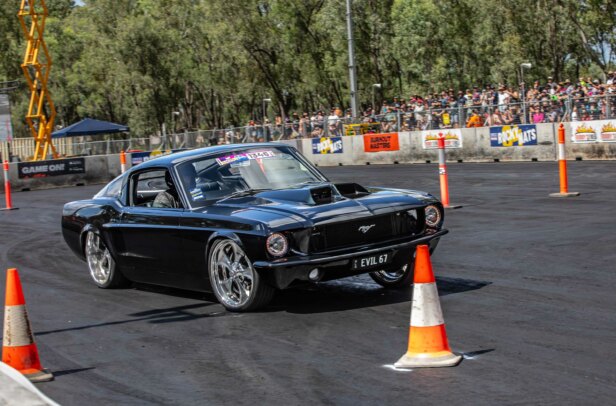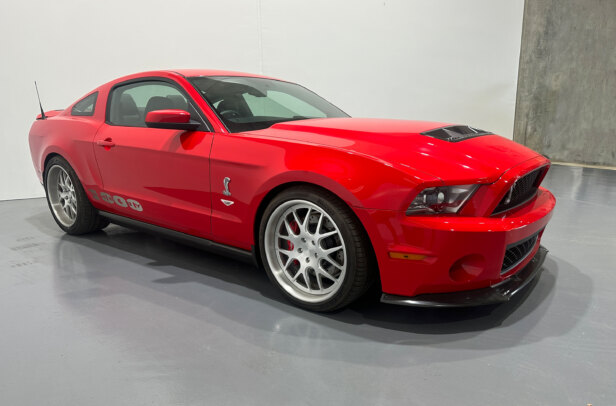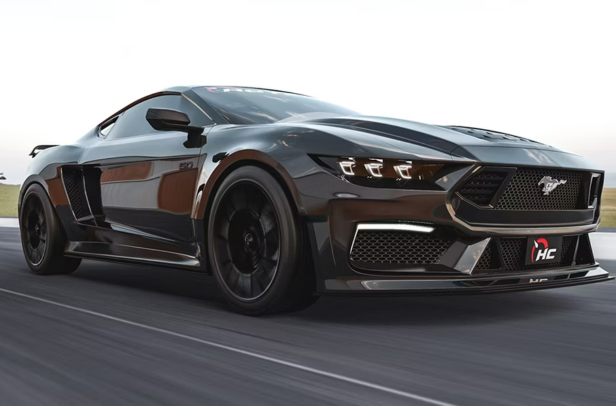“Got a feeler gauge?” I jest to Greg Sadler, in the booth where this sensational 1968 Mustang rests on padded axle stands. It’s a few weeks after Sydney’s MotorEx — where the car debuted to huge acclaim — and I’m finger-nailing the almost non-existent gap between the rear bumper and the body. It’s tight. Crisp. Sharp. So is the rest of the car.
As published in the November 2010 issue of Street Machine
“Three mill,” the man known as Ziggy says. “If I couldn’t get it, I settled for four here and there.”
He’s serious. Serious in his response and serious in the way he, as head of the team at Ziggy’s Hot Rods, crafts a car. At first he doesn’t seem to get my tongue-in-cheek humour about the feeler gauge but he lightens up a little as he explains the philosophy and process behind his first big-time build.
“There’s an easy six months in gapping the car,” he says of the aligning, reworking and reshaping needed to rid a 1960s pony car of its woeful factory panel fluctuations. Now it’s his turn for fun: “Feeler gauges?” he chuckles, handing me a digital Vernier. “Nah mate — we use these instead!”
Although its tolerances make a Lexus body look like a farm fence, the Mustang build didn’t start out that way. It was always going to be a professional build, for a guy called Mike Kluver who had high expectations. But his desire for a tough, top-end Targa-type comp car that was ready for signwriting, safety scrutineering and the starter’s flag changed along the way.
“Mike couldn’t help himself,” Ziggy says. “I suggested we do a low-gloss engine bay and all that — nice and useable — but he wanted all the shiny shite. Shiny rocker covers and all that.
“Before that he wanted a fake Hoey but we couldn’t even get a Falcon roller for 10 grand and you can’t get parts for them. So I suggested a Mustang. They’re easier to find, it’s a Ford that’s always gonna be worth something, and you can get parts.”
Smart thinking, really. The core car — an unfinished project from Sydney — arrived at Ziggy’s, north of Newcastle, NSW, three years ago. Surprisingly, most of the original Ford tin was useable without resorting to the repro parts that Ziggy and many others consider junk.
With the car’s original Targa intentions, a rollcage was an early and important priority. It’s an extensive frame that tucks tight against the turret and pillars and incorporates an X-frame with harness mounts behind the seats.
“With five or 600 horsepower, I didn’t want the car turning itself inside-out,” Ziggy says.
What we’ve done, I reckon, is put into metal what the stylists wanted but the factory couldn’t do
With the car’s shifted priority, the ’cage is now as important for instilling a hewn-from-steel feel to the car as it is for fending off wayward trees.
The firewall was handmade from flat sheet; the suspension towers, with the front wishbones binned in favour of struts, have been reinforced and relieved for the extractors.
Check out the fluid filler caps in the scuttle area. An idea inspired by competition both in appearance and practicality, feeding hydraulics installed high and tight under the dashboard, it’s a visual highlight and makes maintenance easy.
The body’s lower edge has been extended 40mm most of the way around. “We wanted the car to hunker down a bit without chopping the ride height. We also raised the tunnel to fit the Tremec and make room for the exhaust.”
Those fat rear tyres wouldn’t fit without architectural changes and, with the huge fuel tank, that led to plenty of metal work being carried out in the rear half of the car.
However, it’s what Ziggy’s has done to the car’s exterior sheet-metal that’s the least obvious but the most mind-boggling. There isn’t an inch of it that hasn’t been massaged or manipulated. It’s what car designers — and Ziggy — call ‘surfacing’.
There’s a lot more to this body’s prep than filler and filing.
“What we’ve done, I reckon, is put into metal what the stylists wanted but the factory couldn’t really do,” he says. “In fact, there’s not a single surface on Mustangs that’s consistent.” He runs his fingers over the rear of the body to elaborate. “This rear quarter panel; from the factory, there are two radii joined by a flat area. You never notice it on factory cars as the paint isn’t good enough.”
The front guard upper edges were sliced and shifted closer to the bonnet. Same for the boot lid; the upright was sliced off, re-welded, filed and filled for Ziggy’s target of a 3mm gap to the slam panel/tail-light area.
As well as the work to the top edges, the front guards and both doors took about 100 heat shrinks each to get them flat.
The turret was also hot-bopped to refine the shape from the top of the A-pillars to the sailplane area. There was more than a gas torch and a wet rag applied toward the rear, where the sailplanes were finely sliced and tweaked to get the shape just right.
Mike wasn’t sure what colour he wanted on the Mustang. “I suggested a green, then he wanted a dark colour because he wanted it tough. But a dark colour is a bastard so I suggested cream. It’s practical for someone who may not want to spend a whole lot of time looking after it.
“This colour is a classic — hopefully it will still look good in 30 years. Classic colours are timeless and, at the end of the day, better value. I was at SEMA and there were all these wild colours. I was like: ‘Umm, so what?’ A simple straight coat of colour is always an asset.”
But paint is only as good as the panel work underneath and having spent a year on that, the final coat of colour was never going to be rushed. Ziggy started his career as a painter, so no prizes for guessing who was on the gun.
“I spent about 36 hours in the booth, I simply couldn’t leave it — the adrenaline kicked in,” he says of the Glasurit colouring-in session. “But I slept for days afterwards!”
Adrian from Airbrush World laid down the graphics and Ziggy chuckles about the radiator support panel. “It was off the car and he applied the graphic the wrong way ’round! But he fixed it in half an hour. He’s a cool bloke to have around.”
The interior had one or two setbacks too, but it wasn’t related to the skill of the contracted trimmers, Brad and Daz.
“Our leather suppliers, in business since the 1920s, got too much pressure from workcover,” Ziggy says, “so they shut shop! Then the textured material we used as an alternative was discontinued. Of course, we’d already started with items like the sub boxes so we were committed. We eventually found some in Germany. And all this happened in the week before MotorEx.”
The Mustang is motivated by a 427ci small-block built by Sydney’s Pro Flo Performance, based around a World Products block. Holley-fed and packed full of stout stuff, it’s capable of a not-too-stupid 648hp and is mated to a Tremec TKO five-speed and a Strange nine-inch diff with 3.5 gears.
The brakes are Shelby-embossed Baer monoblocks both ends — “Just about the top shelf for a street-driven Ford!” — and a TCI front end with RRS struts and power rack, with a triangulated four-link under the rear. The steering is rack and pinion with long centre-pull tie rods for zippo bump steer.
So while the focus may have changed from comp to romp, with hard-arse hardware now dressed to impress, there’s no question that this Mustang still ticks all the boxes.
GLASS CLASS
You might not realise that the Mustang’s rear quarter windows aren’t standard; normally there’s a vent there. “We had to restructure everything in behind, make a dummy window panel then send it to Protector Autoglass, which made a custom set,” Ziggy says.
The flush-fit windscreen was also a one-off; it’s around 25mm wider and taller than standard due to the deletion of the stainless trim. It features a legal tint and a band across the top, like any late-model car. Ziggy’s has already begun the build of another top-tilt Mustang that will include both these refinements. “That one will have a rear seat for the owners’ kids so they’ll be able to see out.”
MIKE KLUVER
1968 MUSTANG
| Colour: | Glasurit Orange, metalflake roof, white scallops |
|---|---|
| Colour: | Ziggy-mixed Glasurit Cream On Me |
| MOTOR | |
| Engine: | Windsor 427ci |
| Carbs: | Holley 850 |
| Manifold: | Edelbrock |
| Heads: | Edelbrock |
| Pistons: | JE |
| Crank & rods: | Eagle |
| Exhaust: | Ziggy’s dual with Flowmaster mufflers |
| Ignition: | MSD blaster |
| GEARS | |
| Gearbox: | Tremec TKO five-speed manual |
| Clutch: | McLeod |
| Diff: | Strange 9in, 3.5:1 PosiTrac |
| BENEATH | |
| Steering: | RRS power rack Front: TCI with RRS struts and Eibach springs |
| Rear: | Triangulated four-link, Varishock adjustable shocks |
| Brakes: | Baer/Alcon six-piston monoblock calipers, 13.5-inch rotors; RRS under dash pedals |
| ROLLING STOCK | |
| Wheels: | Budnik Shotgun, 18×7 (f), 18×9 (r) |
| Tyres: | Pirelli Nero Rosso, 235/40 (f), 275/40 (r) |
THANKS:
Bob, Sally, Mick, Dave, David, Paul, Pete, Cookie & Col at Ziggy’s Hot Rods; Brad & Daz, trimmers; Kicker Audio USA; Protector Autoglass; Novus Windscreens; Glasurit.




Comments